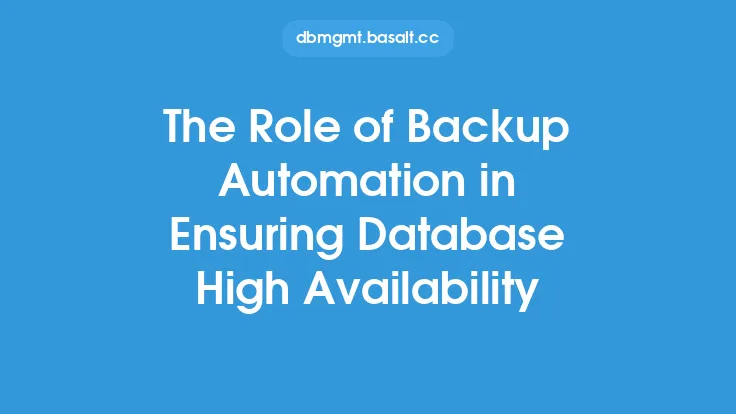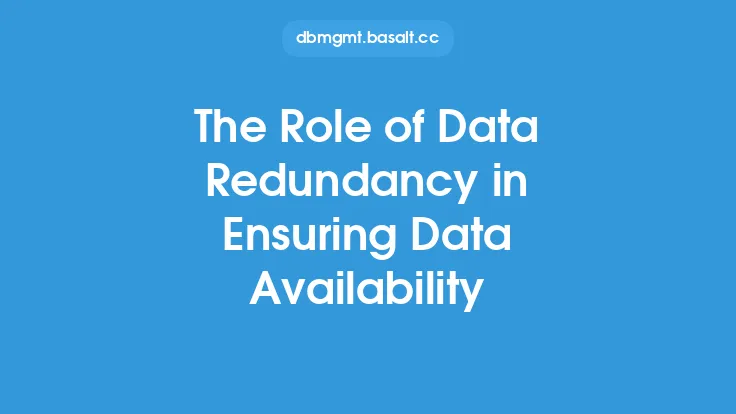Database integrity and availability are crucial aspects of any organization's data management strategy. In today's digital age, databases are the backbone of most businesses, and any disruption to their operation can have severe consequences. One of the most effective ways to ensure database integrity and availability is by implementing a robust backup storage solution. In this article, we will delve into the role of backup storage in ensuring database integrity and availability, exploring the technical aspects and best practices that organizations can adopt to protect their critical data.
Introduction to Backup Storage
Backup storage refers to the process of creating and storing copies of database data to prevent data loss in the event of a disaster, hardware failure, or human error. Backup storage solutions provide a secure and reliable way to store database backups, allowing organizations to quickly recover their data in case of an outage or data corruption. There are several types of backup storage solutions available, including disk-based, tape-based, and cloud-based solutions, each with its own strengths and weaknesses.
The Importance of Backup Storage in Database Integrity
Backup storage plays a critical role in maintaining database integrity by providing a secure and reliable way to store database backups. Database integrity refers to the accuracy, completeness, and consistency of database data. Backup storage helps to ensure database integrity by providing a way to recover data in case of corruption or loss, thereby preventing data inconsistencies and errors. Additionally, backup storage solutions can help to detect and prevent data corruption by providing a way to verify the integrity of database backups.
Backup Storage and Database Availability
Database availability refers to the ability of a database to be accessed and used by authorized users. Backup storage solutions play a critical role in ensuring database availability by providing a way to quickly recover database data in case of an outage or disaster. By storing database backups in a secure and reliable location, organizations can quickly restore their database to a previous state, minimizing downtime and ensuring business continuity. Additionally, backup storage solutions can help to improve database availability by providing a way to perform routine maintenance and upgrades without disrupting database operation.
Technical Aspects of Backup Storage
From a technical perspective, backup storage solutions involve several key components, including backup software, storage media, and network infrastructure. Backup software is used to create and manage database backups, while storage media refers to the physical devices used to store backups, such as disk or tape. Network infrastructure refers to the communication pathways used to transfer backups between the database server and the backup storage device. There are several backup storage protocols available, including Network File System (NFS), Server Message Block (SMB), and Internet Small Computer System Interface (iSCSI), each with its own strengths and weaknesses.
Best Practices for Implementing Backup Storage
To ensure the effectiveness of backup storage solutions, organizations should adopt several best practices, including regular backup scheduling, backup verification, and storage capacity planning. Regular backup scheduling involves creating a schedule for backing up database data, while backup verification involves checking the integrity of backups to ensure they are complete and accurate. Storage capacity planning involves ensuring that the backup storage device has sufficient capacity to store all database backups, as well as any additional data that may be required for disaster recovery.
Common Challenges and Limitations of Backup Storage
Despite the importance of backup storage, there are several common challenges and limitations that organizations may face, including data growth, backup window, and storage costs. Data growth refers to the increasing amount of data that organizations need to backup, while backup window refers to the time available to complete backups without disrupting database operation. Storage costs refer to the expense of purchasing and maintaining backup storage devices, as well as any additional costs associated with cloud-based backup storage solutions.
Future of Backup Storage
The future of backup storage is likely to be shaped by several trends, including the increasing adoption of cloud-based backup storage solutions, the growing use of artificial intelligence and machine learning in backup storage, and the development of new storage technologies, such as flash storage and object storage. Cloud-based backup storage solutions offer several advantages, including scalability, flexibility, and cost-effectiveness, while artificial intelligence and machine learning can help to improve the efficiency and effectiveness of backup storage solutions. New storage technologies, such as flash storage and object storage, offer improved performance and capacity, making them well-suited for backup storage applications.
Conclusion
In conclusion, backup storage plays a critical role in ensuring database integrity and availability. By providing a secure and reliable way to store database backups, organizations can quickly recover their data in case of an outage or disaster, minimizing downtime and ensuring business continuity. To ensure the effectiveness of backup storage solutions, organizations should adopt several best practices, including regular backup scheduling, backup verification, and storage capacity planning. As the amount of data that organizations need to backup continues to grow, the importance of backup storage will only continue to increase, making it a critical component of any organization's data management strategy.





